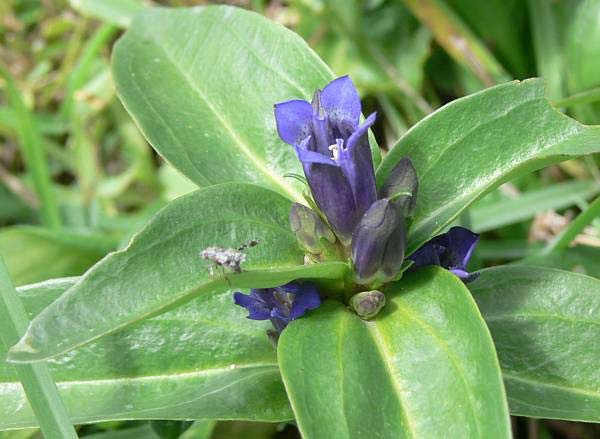
Gentiana cruciata, Photo: Leo Michels
Classification System: APG IV
Superregnum: Eukaryota
Regnum: Plantae
Cladus: Angiosperms
Cladus: Eudicots
Cladus: Core eudicots
Cladus: Asterids
Cladus: Lamiids
Ordo: Gentianales
Familia: Gentianaceae
Tribus: Gentianeae
Subtribus: Gentianinae
Genus: Gentiana
Sectio: G. sect. Cruciata
Species: Gentiana cruciata
Subspecies: G. c. subsp. cruciata – G. c. subsp. phlogifolia
Name
Gentiana cruciata L., Sp. Pl. 1: 334. 1753.
Distribution
Native distribution areas:
Continental: Eurasia
Albania, Austria, Baltic States, Belarus, Belgium, Bulgaria, Central European Russia, Czechoslovakia, East European Russia, France, Germany, Greece, Hungary, Iran, Italy, Kazakhstan, Krym, Netherlands, North Caucasus, North European Russia, Northwest European Russia, Poland, Romania, South European Russia, Spain, Switzerland, Transcaucasus, Turkey, Ukraine, West Siberia, Yugoslavia
Introduced into:
Massachusetts
References: Brummitt, R.K. 2001. TDWG – World Geographical Scheme for Recording Plant Distributions, 2nd Edition
References
Primary references
Linnaeus, C. 1753. Species Plantarum. Tomus I: 334. Reference page.
Additional references
Govaerts, R.H.A. 2003. World Checklist of Selected Plant Families Database in ACCESS: 1-216203. The Board of Trustees of the Royal Botanic Gardens, Kew. [unavailable for the public] Reference page.
Litvinskaya, S.A. & Murtazaliev, R.A. (2013). Flora of the Northern Caucasus: An Atlas and Identification Book: 1-688. Fiton XXI.
Links
Govaerts, R. et al. 2021. Gentiana cruciata in Kew Science Plants of the World online. The Board of Trustees of the Royal Botanic Gardens, Kew. Published online. Accessed: 2021 Jul 17. Reference page.
International Plant Names Index. 2021. Gentiana cruciata. Published online. Accessed: Jul 17 2021.
Tropicos.org 2021. Gentiana cruciata. Missouri Botanical Garden. Published online. Accessed: 17 Jul 2021.
Hassler, M. 2021. Gentiana cruciata. World Plants: Synonymic Checklists of the Vascular Plants of the World In: Roskovh, Y., Abucay, L., Orrell, T., Nicolson, D., Bailly, N., Kirk, P., Bourgoin, T., DeWalt, R.E., Decock, W., De Wever, A., Nieukerken, E. van, Zarucchi, J. & Penev, L., eds. 2021. Species 2000 & ITIS Catalogue of Life. Published online. Accessed: 2021 Jul 17. Reference page.
Hassler, M. 2021. World Plants. Synonymic Checklist and Distribution of the World Flora. . Gentiana cruciata. Accessed: 17 Jul 2021.
USDA, ARS, Germplasm Resources Information Network. Gentiana cruciata in the Germplasm Resources Information Network (GRIN), U.S. Department of Agriculture Agricultural Research Service. Accessed: 07-Oct-06.
Vernacular names
Deutsch: Kreuz-Enzian
suomi: Ristikatkero
français: Gentiane croisette
русский: Горечавка крестовидная, Горечавка крестообразная
српски / srpski: Прострел, сириштара, сириштарка, мала линцура, мали срчаник, отодовка, владисавка
Gentiana cruciata, the star gentian or cross gentian, is a herbaceous perennial[2] flowering plant in the Gentianaceae family.
Description
Close-up on a flower of Gentiana cruciata
Gentiana cruciata is a hemicryptophyte scapose plant of small size, reaching on average 20–40 centimetres (7.9–15.7 in) in height.[3] It has erect stems, the leaves are large, ovate-lanceolate, semiamplexicaul, about 3–8 centimetres (1.2–3.1 in) long. The flowers are violet-blue trumpets with 4 petals, clustered in the axils of upper leaves.[3] The flowering period extends from June to August.[3] The flowers are hermaphrodite and pollinated by insects (entomogamy). The fruit is a capsule. The seeds are dispersed by gravity alone (barochory).
Distribution
Gentiana cruciata is widespread in most of Europe (except Portugal, Great Britain and Scandinavia) and in Western Asia.[4]
Habitat
This plant prefers dry calcareous soil in forest edges, bushy slopes, pastures, grasslands and dry meadows, at an altitude of 200–1,600 metres (660–5,250 ft) above sea level.[3]
Host for Phengaris rebeli
Phengaris rebeli is an endangered butterfly which feeds upon G. cruciata.[5] Female P. rebeli lay their eggs on the upper side of G. cruciata leaves and three to four weeks later, the P. rebeli larvae emerge and begin to feed on the seeds and flowers of this grassland plant.[5] After the P. rebeli reaches its fourth larval instar, it drops to the ground to be picked up by Myrmica schencki ants and brought to their nests.[5]
Female P. rebeli prefer to lay eggs on G. cruciata growing in clumps rather than individual plants, and on the taller plants, as they are less shaded and allow the eggs to grow and develop faster.[5]
Cultural Importance
According to Hungarian legend, a pestilence spread throughout the kingdom during King Ladislaus's reign. Ladislaus prayed for a cure; he then shot an arrow into the air at random, hitting a star gentian plant which cured the illness. This plant became known as "Saint Ladislaus's herb" in Hungary.
References
Biolib
USDA
Pignatti S. - Flora d'Italia – Edagricole – 1982. Vol. II, pag. 331
Luirig
Oškinis, Vytautas (2012). "Relationship between the butterfly Phengaris rebeli and its larval host plant Gentiana cruciata in Lithuanian population". Ekologija. 58 (3): 369–373. doi:10.6001/ekologija.v58i3.2533.
Retrieved from "http://en.wikipedia.org/"
All text is available under the terms of the GNU Free Documentation License

